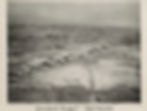100 Years of Historic Firsts at CLE
- Paul Soprano
- Jun 8, 2025
- 9 min read
Updated: Jun 30, 2025

On July 1, 2025, Cleveland Hopkins International Airport will celebrate 100 years of service to Northeast Ohio and the world. It may be hard to believe, given how dated Ohio’s largest airport is today compared to other similar-sized facilities around the country, but Hopkins has a very storied and historic past, including numerous airport “firsts” and technological innovations. The historic firsts, which are not widely known, are detailed below.
Second oldest municipally owned airport in the United States still in continuous operation at the same location (1925). [Note: CLE airport officially still claims it is the first, however, there is evidence that Long Beach Airport (LGB) in California was established in November 1923, and opened in December 1924, beating CLE by half a year. Click here for more information about this claim).
First seasonal scheduled interstate passenger services in the United States (1922)
First air-freight route started by the Ford Motor Co. to and from Detroit (1925)
First National Air Races (1929)
World’s first airfield lighting system (1930)
First air traffic control tower with airplane-to-tower radio communication system in the United States (1930)
First passenger information board providing schedules of more than one airline (1956)
World’s first airport-based Emergency Medical Technician (EMT) program established (1965)
First direct airport to downtown rail service in the Western Hemisphere (1968)
Commercial aviation in Cleveland began almost seven years before Cleveland Municipal Airport opened in 1925. The first regular airmail service was started in December 1918. However, Cleveland’s two existing privately owned airfields were not equipped for night flying and the city was in danger of losing its important airmail stop. (Click here for the story of the early days of aviation in Cleveland.)
Visionary Cleveland City Manager, William R. Hopkins, after whom the airport was named in 1951, began the search for a more appropriate airfield, which could accommodate future growth. The current site on the southwest side of Cleveland was selected, and in January 1925, a $1,250,000 bond issue was approved by the city council for land acquisition and construction of an airport. construction on the first landing field and airport structures, US Air Mail Hangars, began quickly.

Only seven months after the bond issue, the new airport was open for business in a public spectacle that attracted 100,000 visitors. How quickly things moved back in the day! The first mail plane of the day, a World War I surplus DeHavilland DH-4, landed at 8:30 p.m. from Chicago and continued on to New York, inaugurating night air mail service between the cities. Air freight between Detroit and Cleveland started with the first car (disassembled) flown to Cleveland from Detroit by the Ford Motor Company on July 11, 1925, and assembled right at Cleveland Airport.

But it took over two years before Stout Air Services (formed out of the Ford Motor Company’s flying division) started the county’s first scheduled year-round interstate passenger service between Cleveland and Detroit on October 31, 1927.




Two technical experts, hired by the Post Office Department, came to Cleveland in 1925 to help establish adequate landing facilities. They were Major Jack Berry, the first airport commissioner, and Claude F. King, a lighting and radio expert who eventually became the second commissioner. (Click here for more details on the site selection for CLE.) Berry foresaw the benefits of commercial aviation and became a respected national expert on airports. While Berry never flew, he respected fliers and knew what they wanted and needed to fly safely. For example, he stated, “Pilots don’t like crosswinds. Let’s pave the whole damn field and they can land any direction they want to.” This was done. A huge landing mat was built instead of conventional runways.


King invented, constructed, and installed the first airport control tower in the United States in 1930 (which was eventually replaced in 1956, in 1988, and in 2015, with the present tower). For the first time, radio communication was used to direct air traffic using equipment borrowed from the United States Coast Guard.


However, night operations at airports were still tricky, so Berry and King acquired a huge marine search light in 1930 to illuminate the field. The intense light was so blinding that a man was required to walk in front of the beam to shield the cockpit from the light. King solved this problem by developing and installing a light bar, which provided a remote-controlled shadow for the pilots. Parts of this lighting system and the first control tower are at the Smithsonian Institution’s National Air and Space Museum in Washington, DC.



Because of the city’s huge airfield, Cleveland was selected as the site for the first National Air Races and Aeronautical Exposition in August-September 1929. The Air Races drew hundreds of thousands of spectators each year, and attracted the likes of Charles Lindbergh, Jimmy Doolittle, Rosco Turner, and Amelia Earhart. The National Air Races were suspended during World War II and finally ended in 1949, after a tragic accident in which a P-51 Mustang crashed into a nearby home, killing the pilot and two residents in the house. Their legacy continues, however, with the annual Cleveland National Air Show, held each Labor Day weekend at Burke Lakefront Airport (BKL).




Post-World War II growth at the airport made the original terminal quickly obsolete. Plans were drafted by the local architectural firm of Outcalt, Guenther & Associates for a brand new $4.3 million modern terminal. A new West Concourse (now Concourse B) was opened in May 1954 complete with a rooftop observation deck, while the two-level main terminal was opened in April 1956, followed by the North Concourse (now Concourse A) in October 1957. Architectural Forum magazine (November 1952) praised the terminal design as providing "the best circulation pattern of any large US airport...It is surprisingly close to the theoretical best described by CAA."




Claude King continued his innovations, designing the world’s first centralized electric information board in the new terminal that opened in 1956. Information on up to 32 flights could appear at the same time, with information updated regularly from air traffic control and the airlines. Today such boards, or their electronic successors, are used in most every major airport in the world. Despite this innovation, it took Cleveland decades after the 1970’s era terminal replaced the 1950’s terminal to again install a centralized flight information display system.

The 1960’s saw a number of additional Cleveland airport “firsts.” The first emergency medical technician program at an airport was established at Hopkins in 1965. And a federal grant financed a four-mile rail extension to create the first direct rapid transit link from an airport to downtown of any North American city that was launched on November 15, 1968, by the Cleveland Transit System (CTS). Today, the Regional Transit Authority’s RTA Red Line operates from a renovated station in the lower level of the airport terminal. The 30-minute ride downtown costs only $2.50 and runs every fifteen minutes.
Despite all these historically significant developments, Hopkins Airport did not expand as much or as quickly as other airports after the 1960’s. While other cities built new airports in less developed areas, Cleveland Hopkins remains in its original landlocked location. There were (fanciful) plans to build a new jetport offshore in the middle of Lake Erie, or in Ravenna, but those plans never came to fruition.

Serious social and economic problems racked the city in the late 1960’s and early 1970’s and diverted the attention of the city’s leadership away from long-term, commercial aviation concerns. Nonetheless, a major expansion and modernization of the terminal facilities was undertaken in 1973 and completed almost a decade later.

Significant modernization of the airfield was also undertaken and completed in 2008, which greatly improved safety and capacity, albeit at a time of decreasing flight operations.

Since then, with the exception of the construction of Concourse D for Continental Airlines in 1999, and the largely cosmetic terminal renovations completed in 2016, before the Republican National Convention came to town, there has been no significant new construction on the almost 50-year-old terminal complex, parts of which date to the mid-1950s.
Furthermore, there have been no innovations at CLE since 1968’s rapid transit link to downtown. And the airport has played catch-up with trends that have become common-place at other airports for decades, such as a centralized flight information display system (FIDS), cramped and overtaxed TSA security checkpoints, customer-friendly amenities, particularly outside of the secure area, a woefully outdated international arrivals area, inadequate on-site parking, car rental facilities that cannot be reached on foot, and cramped restroom facilities that are not beloved by the traveling public.
Thankfully, a new airport master plan and a new airport director are in place to move the airport into its second century. In a "bold departure" from the original designs of the master plan, CLE revealed in May 2025, its latest vision for a new landside front door to the city.


The airport states, "Coinciding with our upcoming 100th anniversary celebration, the launch of CLEvolution: The Campaign to Transform Cleveland Hopkins International Airport, marks a major investment to modernize CLE over the next decade. The evolution of this critical regional asset will not only revolutionize the air travel experience for local residents and visitors alike but also position Northeast Ohio for future growth and greater economic prosperity." More information, including initial photo renderings, timelines, and videos showing the transformation can be found here: https://itsaclevolution.com/ Below are some preliminary renderings of the new terminal headhouse. (City of Cleveland, Department of Port Control)
Long-time architecture critic, Steven Litt, offered this analysis of the initial terminal renderings for Ideastream Public Media. We will look into these and other issues in future articles. Stay tuned.

A previous edition of this article, created in partnership with Max Groot from AirportHistory.org, and featuring more images, can be found here: https://www.airporthistory.org/cle-95-years.html
Paul J. Soprano is an amateur aviation historian and proud AvGeek who has a special interest in airports, especially his beloved hometown airport, CLE!
















